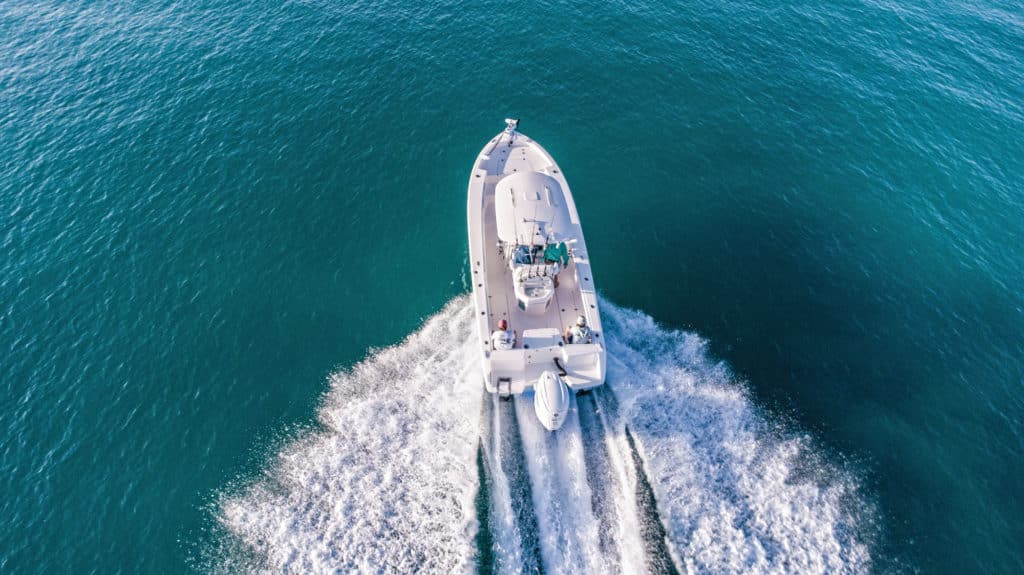
When shopping for an inshore-fishing boat, there’s nothing to match time on the water to help solidify a decision. And certainly the particular qualities of any boat become fully realized only after spending time using it.
But prior to the first fishing trip or sea trial, inspection of construction, components and systems—in the showroom or on the boat-show floor—provides valuable insight that foretells a long and satisfying ownership experience.
Look for the signs of quality and care in design. You’ll pay for quality now—or later in maintenance and repairs, inconvenience, or worse: downtime when you could be on the water on a hot bite.
Hull and Deck
The hullsides should be the first thing you look at. Sighting along the sides, look for a glass-smooth surface, without ripples or print-through from the fiberglass matting. Structural components inside should not give themselves away on the outside.
A well-built boat will have structural elements installed in the mold rather than fastened in later. A flawless expanse of gelcoat speaks to the mold maintenance, and offers a clue to the general care taken in manufacturing.
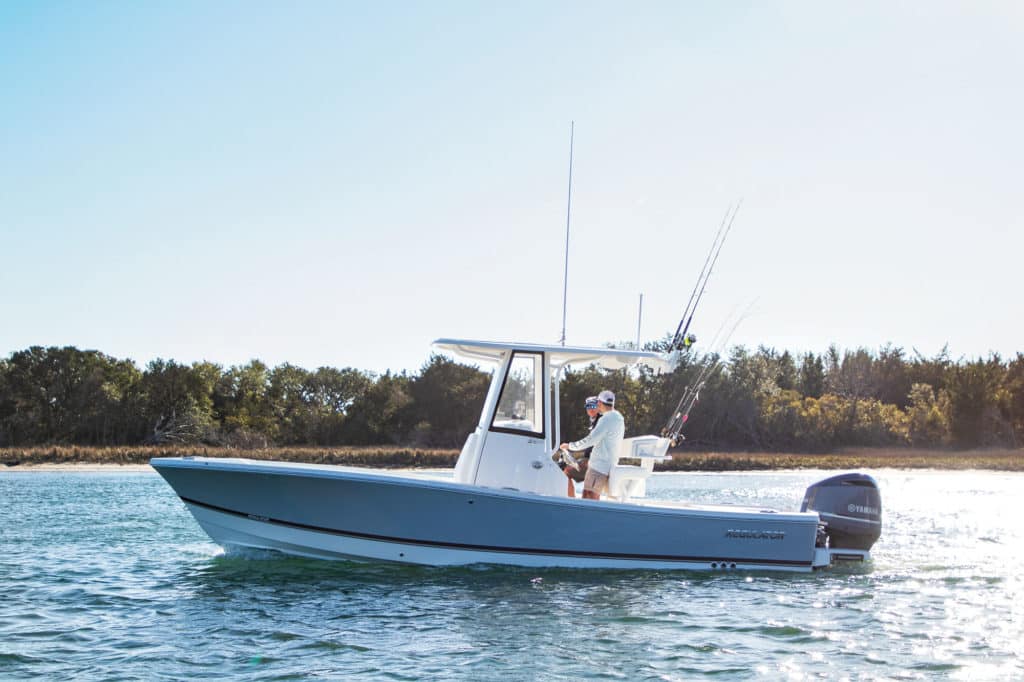
Check out the rub rail. It should be stainless steel, screwed, with screws flush or countersunk over a semirigid bumper rail, mounted on a reinforced line between the hull and the cap.
Stepping aboard, the first instinct is to imagine yourself fishing in this boat, and that’s the right instinct.
Determine right off the bat if the layout and arrangement of the interior are where you’d like to spend fishing time.
“Make sure you have the storage to hold the gear and equipment you will need for your style of fishing,” says Jeff Martin, advertising, social media and co-op coordinator for Skeeter Boats.
Is there proper and adequate seating for expected companions? Of survey respondents, 78 percent fish with friends, 69 percent with family, 50 percent fish alone, and 8 percent fish with a dog.
That determined, look for uniform nonskid on the cockpit sole. Retractable or recessed cleats create a snag-free space. Rails should sit in recessed channels or be canted inward to make moving around the boat effortless. Grab bars should be inconspicuous but intuitive in their placement. “On the water, things happen fast,” says David Clubbs, director of engineering for Regulator Boats. “Grab bars have to be in the right place for split-second decisions, and they should be laid out with that mindset. If the interior is set up with only leisure in mind, you are going to miss something.”
Helm
Command central—the helm—is where you’ll spend a lot of time. Convenience, safety and efficiency are paramount. Steering wheels and throttles should be easy to reach whether you’re seated or standing.
Armrests, if present, should fold up, and be sturdy enough to withstand the stress of rough conditions or high-speed maneuvering.
Anything around the helm is likely as some point to see duty as a grab bar. Seating modules should be rock-solid, as should framing around a windshield, whether it’s acrylic or the increasingly popular tempered glass.
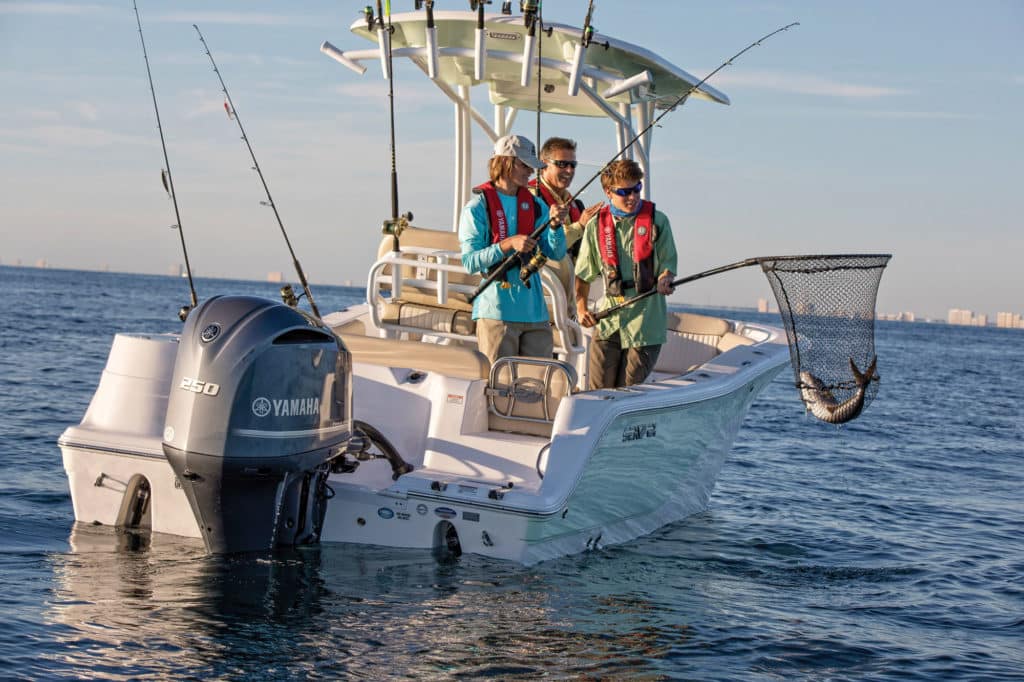
The view forward should be unobstructed, allowing the skipper to see the forepeak, with sightlines all around, relatively unobstructed.
Primary in helm ergonomics is access to electronics. Of survey respondents, 88 percent preferred a single combo display no larger than 12 inches, so space is scarcely a consideration. Placement is, however.
“In the past, electronics were installed in overhead boxes,” says Lanie Martin, director of sales and marketing, Stamas Yachts. “It’s nicer to install them all on the dash so you just glance down, without having to interrupt your line of sight.”
If electronics that require special accommodation are part of the final plan —radar, spotlight or night-vision cameras—you’ll need a top hamper, either a T-top or hard sunshade. Check construction and mounting: Is it installed solidly through the deck, or on the console sides? On powder-coated aluminum, look for nylon washers around screws, which will reduce chipping.
The underside of overheads should be a dark color to reduced glare over the electronics. Rounding out a well-appointed helm, a traditional compass sits centered over the wheel, atop the console.
Hatches and Storage
More than two-thirds of survey respondents prefer to on- and off-load tackle for each trip, rather than store it permanently aboard, so convenience and ease of access to storage becomes paramount.
If you are one of the 30 percent who keeps tackle aboard, locking storage—and locking rod storage in particular—is a detail you’ll want to look for.
All locking hatches throughout the boat should be keyed alike.
Watertight hatches need to be generously guttered around the perimeter, to drain overboard or to the scuppers, rather than into the bilge. Robust gaskets and pressure latches ensure that what’s inside remains dry.
Hinges should lie flush with the top of the lid to avoid snagging your toes, and be through-bolted, not screwed, in most cases.
“In places where hinges fasten near a seam or in a radius, and you can’t back-nut it, we have to use screws,” says Charlie Johnson, vice president, Maverick Boat Company and Pathfinder Boats. “But we cast a phenolic layer into the hatch lid to support the hinge fasteners.”
Hatch lids should allow access to the full hatch opening, but lid support is essential.
Hatch lids should not open to lean against anything, which can wear on the lid or the boat. Increasingly builders are using friction hinges, which hold the open lid in place. Bigger hatch lids demand other solutions.
“Large hatch lids should be strut-supported,” explains Lanie Martin at Stamas Yachts. “If it’s too heavy for a friction hinge, it needs gas-ram struts to hold it open.”
In such cases, struts should be mounted so that they don’t interfere with loading and unloading the hatch.
Livewells
If live-baiting is your game, then the livewell is the life-support system for a successful day of fishing.
Among respondents to our survey, 21 percent fish live bait all the time; 43 percent use live bait half the time. Two thirds of respondents carry a few dozen baits at a time, while a third need accommodation for six to 12 dozen baits.
Livewells should be able to accommodate both scale baits and crustaceans.
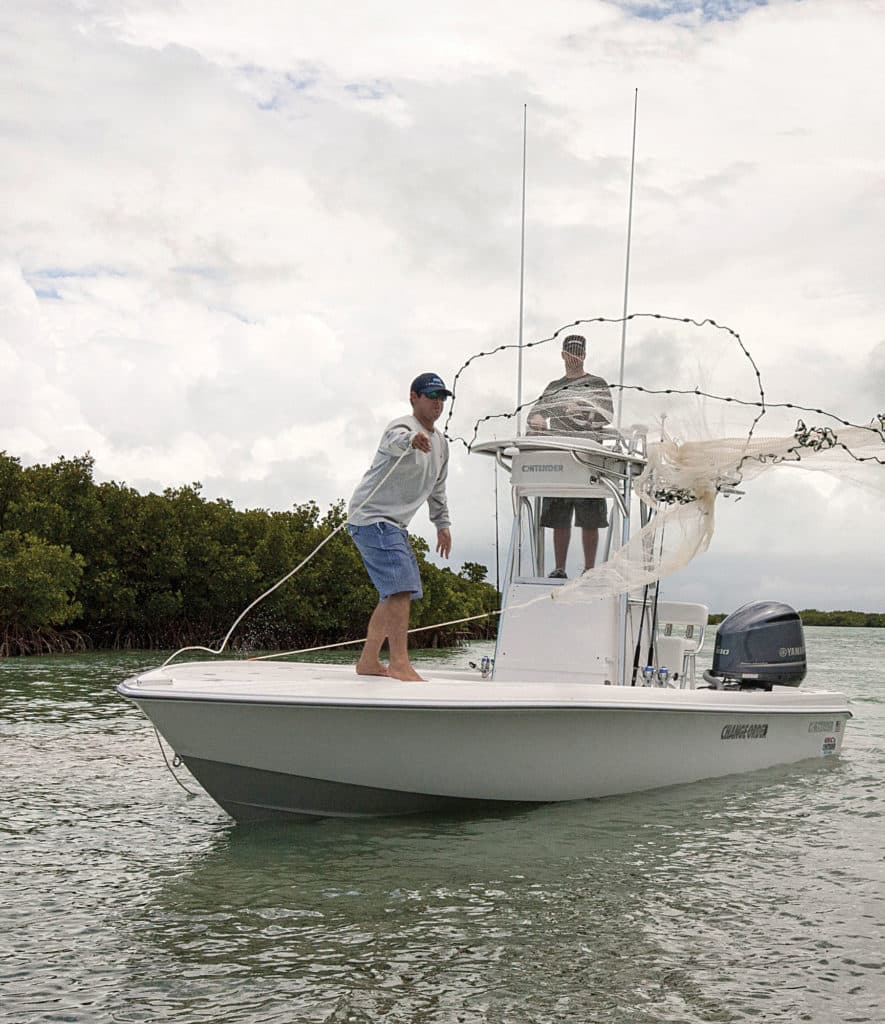
“We offer separate livewells for inshore fishing,” says Jordan DeLong, director of marketing, Contender Boats.
“One for the hardier scale baits and another for shrimp or crabs. But basically we customize the livewells to the customer’s preference, and configure them to the needs of their area and how they fish live bait.”
Options abound. Sea chests, which pump water into a holding tank and then to the livewell, provide a consistent supply of water at any speed. They also prevent pumps losing prime. In lieu of that, having dual pumps—backup redundancy—guarantees a reliable flow of new water into the well in case of pump problems.
Livewells should be constructed without severe angles on the interior.
“Circular or oval wells are preferable so no hard angles affect the liveliness of bait,” says Lanie Martin, of Stamas. “Another nice feature is visibility, either a clear lid or an aquarium-style baitwell, so it’s easy to keep tabs on your bait, make sure everything is working right, and that nobody accidentally turned off a switch.”
Livewell lids should fold back flat out of the way, or open wide on friction hinges, in order to provide adequate clearance for filling from a cast net or by hand, without roughing up the baits.
Plumbing
Plumbing, aside from livewells and washdown systems, has a single purpose: to keep water where it belongs, which is outside the boat.
From rainstorms to taking an errant wave over the bow, there are plenty of ways for water to get in, some of them not always evident.
Rod and cup holders, if they are open at the bottom, should be plumbed to drain out the scuppers or overboard rather than into the bilge. Removal of water in the bilge depends on a pump, which depends on battery power, two systems that could fail at the worst time.
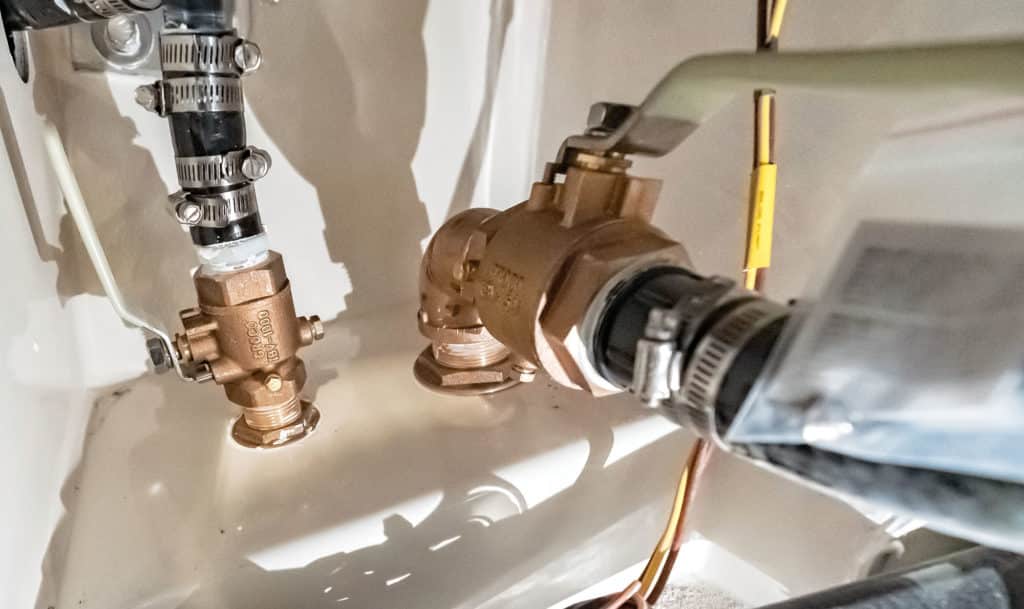
Hatch gutters should be oversize to drain quickly. Deck scuppers should sit above the waterline when the boat is at rest to ensure rapid draining.
Any through-hull fitting below the waterline should be sealed and double-clamped for safety. Through-hull fittings should be inspected closely.
“Nylon or plastic through-hull fittings are likely to fatigue and crack,” says Lanie Martin at Stamas. “We prefer high-quality stainless fittings. But you have to really look closely sometimes because some fittings are nylon with stainless caps.”
For heavier applications, such as larger drain lines and holding tanks, bronze fittings are preferable for their extra durability and strength.
The way drainage and plumbing is routed through the bilge is important as well. No waterlines should run above electrical systems, where seepage of salt water could drip onto wiring or other components.
Waterlines and drain lines should run straight whenever possible.
“We do a lot of work aligning plumbing,” says David Clubbs at Regulator. “Make sure the hoses drain without sags or traps so there is no freeze hazard. Quality plumbing is more than just getting water out of the boat.”
Electrical Systems
The electrical system is the nerve center of any boat. If it doesn’t hold up to saltwater service, nothing will work right.
Circuit breakers have largely replaced fuses, even on smaller boats, and as a first line of investigation in troubleshooting, breakers should be accessible near the helm. On a proper panel, all wires are labeled within 6 inches of their terminal.
Breakers should be labeled as well, if the wires are obscured by the breakers. Terminals should be tinned copper, and any splices sealed and shrink-wrapped. Service loops—spare wire—at the terminals allow easy maintenance of electrical components.
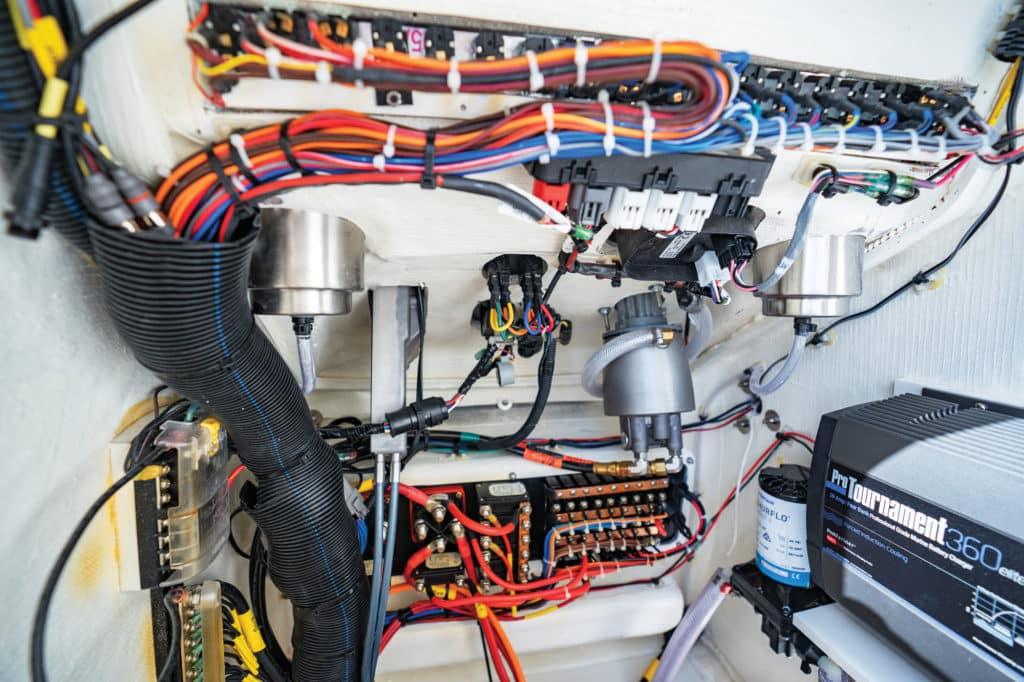
Hallmarks of a sound harness are continuous runs, without splices. Deutsch connectors are standard among experienced builders.
Quality wiring follows American Boat and Yacht Council guidelines, which specify colors coded for features or accessories. National Marine Manufacturers Association certification follows these guidelines, and both endorsements ensure uniformity in construction, simplifying repairs.
The best builders not only configure a wiring harness for each model they make, but for each boat they build as well.
“Our boats are going to outlive the pace of electronics improvement,” says Regulator’s Clubbs. “A good design can be maintained and upgraded later as improvements come on the market.”
A lot of electrical rigging is hard to see, but when visible, it offers insight to quality work. All wires and connections should be up out of the bulge and well-secured.
“Vibration creates wear when wires aren’t well-anchored. Any movement is likely to show up as exposed copper over time,” Clubbs says.
With an eye to retrofitting, 65 percent of bay-boat shoppers in our survey intend to install a trolling motor, and 45 percent at least one shallow-water anchor.
If that’s you, pre-wiring in the appropriate location can greatly ease installation of these accessories.
Lastly, don’t forget to check for adequate 12-volt and USB charging outlets.
Fuel
Fuel systems go largely unnoticed on a bay boat, aside from the recognition that you put money in one end, which generates nautical miles and fishing time at the other end.
Aside from keeping the tank full and periodically changing filters, inspect connections frequently for leaks.
Fuel tanks are preferably of coated aluminum, but increasingly nonpermeable poly tanks are acceptable. Either should be mounted on a false bottom, with spacers to allow water to drain past. Fuel lines of the appropriate size for the engine should be anchored securely, by themselves, and make as direct a line from the tank to the engine as possible. Deviations, sags or unnecessary bends slow fuel flow and put additional burden on the fuel pump, which might necessitate replacement before its time.
Fuel filters demand regular changing, so access should be easy, with plenty of space to work in. Throughout the system, reputable builders recommend parts matched to the engine.
“We use all Yamaha components throughout the system,” says Charlie Johnson of Maverick. “This makes for maximum compatibility. It’s also important for warranty considerations.”
Check for access, usually a pie hatch, over the sending unit on the fuel tank. They are notorious for failure. As well, should the fuel tank itself need attention, there should be a semipermanent access panel over the fuel tank. This often looks like a big hatch in the cockpit sole, sans hinges. It’s usually sealed semipermanently into the deck, and is designed to be removed only when complete bilge access is required.
Without that access panel, partial deck removal might be the only way to get to the tank for repair or replacement.
Bay-Boat Checklist
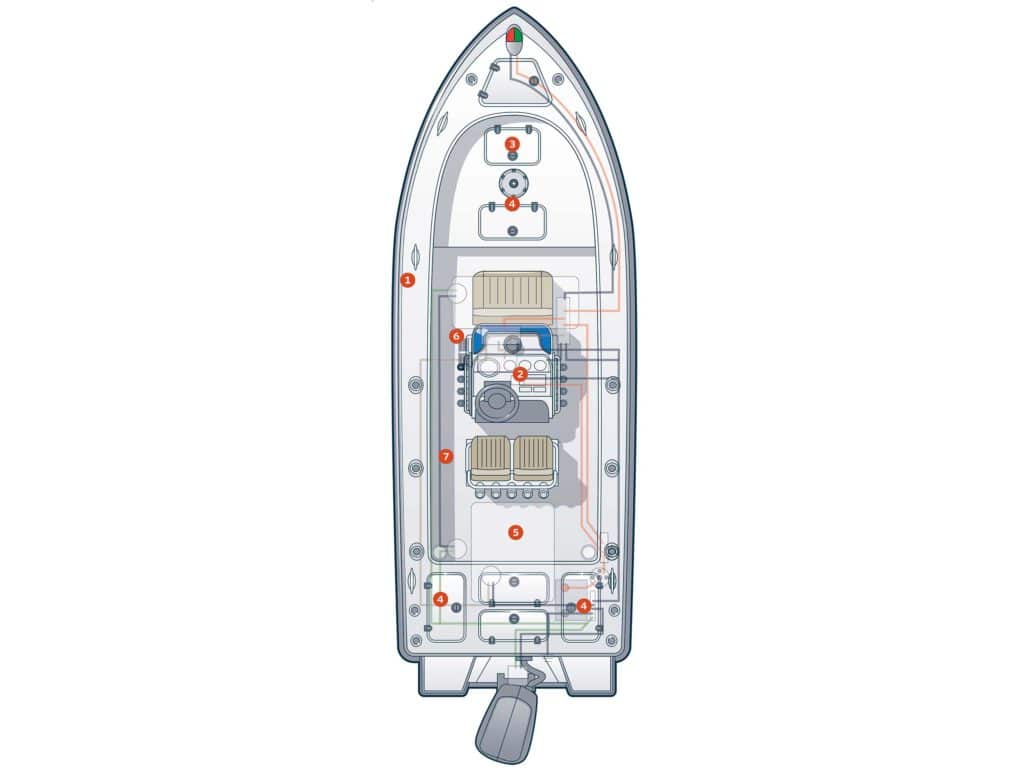
- Look for pleasing aesthetics, fiberglass matting or bulkhead print-through visible when sighting down the gelcoat surface.
- Sightlines to instrumentation should be unobstructed, controls in comfortable reach, and visibility a clear 360-degrees.
- Proper storage, at least some of it dry, enhances fishability and safety by keeping the deck and crew organized.
- Livewell-pump capacity should be able to replace livewell water every 10 minutes. Clear lids are important.
- Waterlines, through-hull fittings and pump connections should be double-clamped, sealed and easy to access.
- Wiring should be organized and labeled within 6 inches of either end. Fuse blocks are superior to in-line fuses.
- Fuel lines should be double-clamped. Fill lines must not sag, and the tank should be protected from corrosion.





